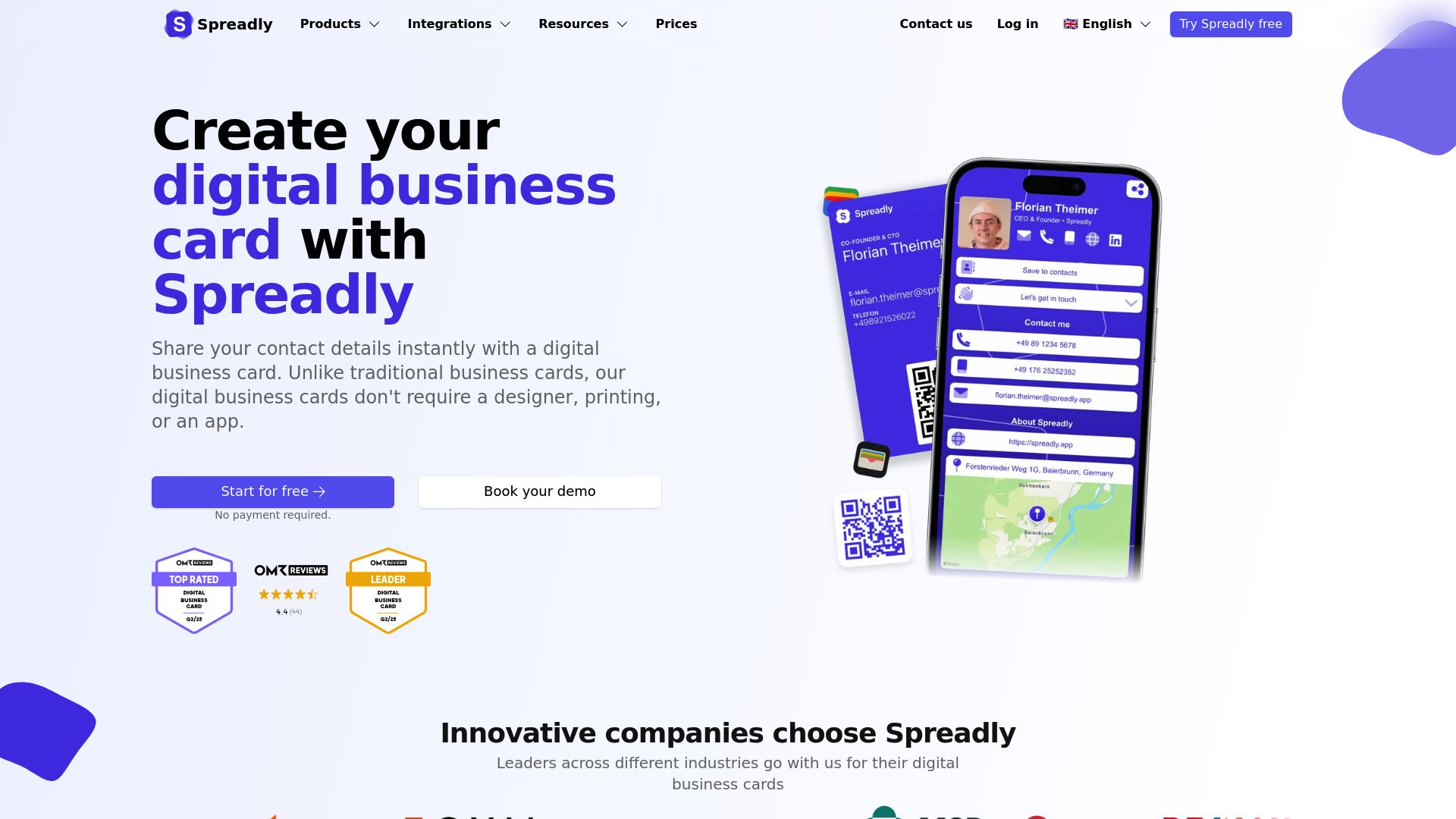Share Card Guide: Essential Steps for Success in 2025
14 minutes
11th of October 2025
In this article:
- Understanding Share Cards in 2025
- Essential Steps to Creating a Successful Share Card
- Sharing and Distributing Your Share Card Effectively
- Customization and Personalization Strategies
- Measuring Success and Optimizing Performance
- Advanced Tips and Pro Strategies for 2025
In today’s fast-paced digital world, the way we connect and exchange contact details is transforming at an unprecedented pace. Whether you’re growing your professional network, building a brand, or fostering business relationships, staying ahead means adapting to smarter, more efficient tools.
This guide is designed to help you master the share card, providing clear, actionable steps for networking success in 2025. Discover the latest strategies, tools, and best practices to maximize your impact.
Ready to streamline your connections? Explore what share cards are, why they matter, and how you can leverage them for measurable results in the digital age.
Understanding Share Cards in 2025
The world of networking is undergoing a remarkable transformation as we move further into the digital era. The share card has quickly become the centerpiece of modern connections, delivering flexibility, speed, and measurable impact. Let's explore how the share card has evolved, what it offers today, why it matters more than ever, and who stands to benefit most from its adoption.

Evolution of Share Cards: From Paper to Digital
Business cards have long been the go-to tool for exchanging contact details. However, the shift to digital formats has accelerated due to remote work, global business demands, and sustainability. It’s striking to note that 88% of paper business cards are discarded within a week, highlighting inefficiency and waste. As industries embrace flexible work, share card solutions have gained traction in tech, finance, healthcare, and events. This evolution reflects a broader push for eco-friendly practices and instant, borderless communication.
What is a Share Card? Key Features and Formats
A share card is a digital, interactive contact card that allows real-time updates and instant sharing. Unlike static paper cards, a share card can take several forms: QR code cards, NFC-enabled cards, wallet passes, and email signature cards. Essential features include contact details, social media links, brand elements, and even embedded multimedia. This seamless integration of information and technology sets the share card apart from traditional cards, enabling users to keep their details current and engaging.
Why Share Cards Matter in 2025
The share card is more than just a digital replacement—it’s a strategic asset in today’s networking landscape. Virtual networking is on the rise, and companies are prioritizing eco-friendly solutions. According to Digital Business Card Adoption Statistics, digital networking is projected to grow 20% year-over-year, fueled by user preference for convenience and sustainability. Organizations leveraging share card technology report higher engagement rates and faster follow-ups, giving them a clear competitive edge in 2025.
Benefits and Challenges
The main benefits of adopting a share card include convenience, real-time updates, broader reach, and significant cost savings over print. Users can update their information instantly, ensuring contacts always have accurate details. However, challenges remain: some users face tech adoption barriers, and privacy or security concerns may arise. These hurdles are being addressed through secure share card platforms, GDPR compliance, and ongoing user education, making digital cards safer and more accessible.
Who Should Use Share Cards?
A share card is a smart choice for professionals, entrepreneurs, sales teams, and event organizers. It shines at networking events, conferences, and within remote teams, enabling seamless connections and efficient lead generation. Use cases range from onboarding clients and building brand presence to collecting leads at industry events. As the share card becomes standard practice, it empowers users to create memorable, measurable, and impactful first impressions.
Essential Steps to Creating a Successful Share Card
Building a standout share card in 2025 means combining strategic intent, the right technology, and a focus on user experience. Each step below ensures your share card becomes a powerful tool for networking, brand building, and measurable growth.
Step 1: Define Your Purpose and Audience
Begin by clarifying your primary objectives for the share card. Are you aiming for lead generation, personal branding, or broader brand awareness? Pinpointing your networking goals ensures every element aligns with your intent.
Next, segment your audience. Consider prospects, partners, employers, or clients. Tailor your share card content to resonate with each group. For example, highlight project portfolios for creative industries or certifications for tech events.
Customize your share card for different scenarios. If attending an industry-specific event, update visuals and messaging to match the audience. This focused approach maximizes relevance and engagement, setting the stage for meaningful connections.
Step 2: Choose the Right Share Card Platform
Choosing the ideal platform is crucial for share card success. Evaluate options based on ease of use, customization, integrations, and security. Consider whether you need a free or paid solution, or prefer an app-based or browser-based tool.
Leading industry platforms offer varying features. Some excel in design flexibility, while others prioritize analytics or CRM integration. Compare providers to see which aligns best with your goals.
Key evaluation criteria include:
- User-friendly interface
- Branding and customization options
- Integration with digital tools
- Strong data privacy and security
Selecting the right share card platform lays the foundation for streamlined, effective networking.
Spreadly: A Modern Solution for Digital Share Cards
Spreadly stands out as a cutting-edge share card solution for 2025. It allows users to instantly share and update contact details without needing physical cards or mandatory app downloads.

Key features include rich media support, customizable branding, lead capture forms, and seamless integrations with CRM and HR platforms. This versatility supports individuals, teams, and large enterprises alike.
With millions of shares and adoption by leading organizations, Spreadly delivers proven results. Users report higher engagement and more efficient follow-ups. Getting started is simple, with free setup, interactive demos, and app access available to all.
Step 3: Design and Customize Your Share Card
Visual branding is essential for a memorable share card. Incorporate your logo, brand colors, and distinctive fonts to ensure every interaction reinforces your identity.
Go beyond basics by adding interactive elements. Video introductions, downloadable files, and clickable links create an engaging, dynamic experience for recipients. Prioritize mobile optimization and include alt text for images to boost accessibility.
For best practices on design and information inclusion, see Designing Effective Digital Business Cards. Experiment with interactive backgrounds or branded templates to further enhance engagement and impact.
Step 4: Add Essential Information and Media
A successful share card includes all critical contact fields:
- Name and job title
- Company name
- Phone number and email
- Social media profiles
Optional additions can include scheduling links, product demos, portfolios, or testimonials. Always assess what information is necessary for your audience. Respect data privacy by sharing only what's required and adhering to GDPR best practices.
For event networking, consider embedding a lead capture form directly within your share card. This streamlines follow-up and ensures no valuable contact slips through the cracks.
Step 5: Test and Preview Your Share Card
Before sharing, thoroughly test your share card across all devices: mobile, desktop, digital wallets, and NFC readers. Confirm that QR codes scan easily, links work, and visuals display correctly everywhere.
Gather feedback from peers or colleagues. Use A/B testing to compare different versions, focusing on user experience and clear calls to action. Ensure recipients can save your information with minimal effort.
Regular testing guarantees your share card remains effective and up-to-date, providing a seamless experience at every touchpoint.
Sharing and Distributing Your Share Card Effectively
Sharing your share card is more than a technical step—it's the bridge that turns networking opportunities into meaningful connections. Choosing the right channels and following best practices ensures your contact details reach the right people, at the right time, in a secure and memorable way.

Step 1: Selecting Distribution Channels
Selecting the ideal distribution channel for your share card can make or break your networking success. Today, options include QR codes, NFC-enabled cards, unique personal links, wallet passes, and integration into email signatures.
Each channel offers unique advantages. QR codes are perfect for in-person events like conferences—simply display your share card on a badge or banner, and attendees can scan to connect instantly. NFC cards allow for contactless sharing, ideal when speed and convenience matter. Wallet passes give recipients a way to save your details directly to their devices, while email signatures enable ongoing passive distribution.
Increasingly, professionals are turning to digital solutions not only for convenience but also for sustainability. Digital business cards help reduce paper waste and support eco-friendly networking. For a deeper look at why this matters, see Digital Business Cards and Sustainability.
Step 2: Best Practices for Sharing
Timing is critical when sharing your share card. Share it before a meeting to set the stage, during an event for immediate connection, or after a conversation to reinforce your touchpoint.
Personalize your approach. When sharing a link or digital card, add a custom message tailored to the recipient. This can transform a generic exchange into a memorable interaction. For example, after a networking event, send your share card via LinkedIn with a brief thank-you note referencing your conversation.
Follow-up is essential. Use automated reminders or scheduled messages to prompt ongoing engagement. This proactive strategy increases response rates and helps keep your network warm, ensuring your share card remains top of mind.
Step 3: Integrating with Digital Tools and Platforms
Integrating your share card with digital tools amplifies its impact. Sync your contact data directly with CRM systems like Salesforce or HubSpot to streamline lead management. Embedding calendar or scheduling links makes it easy for recipients to book meetings, reducing friction in the follow-up process.
Leverage analytics to track how often your share card is viewed or shared. Platforms with robust analytics reveal which channels drive the most engagement and which connections convert to leads. For example, measuring lead conversions from share card interactions at a trade show can demonstrate ROI and guide future networking strategies.
Step 4: Ensuring Security and Privacy
Protecting your data is vital when distributing your share card. Use secure sharing methods, such as password-protected links or expiring access, to prevent unauthorized access. Always ensure your platform complies with privacy regulations like GDPR or CCPA.
Educate your recipients on safe information handling. Share best practices, such as not forwarding sensitive details without permission. By prioritizing security and privacy, you build trust and ensure your share card enhances your professional reputation while safeguarding all parties involved.
Customization and Personalization Strategies
Customization is the secret to making your share card stand out in today’s digital-first networking landscape. As the competition increases, unique design, tailored content, and accessible features drive real engagement and connection.

Advanced Design Techniques
In 2025, design innovation is at the heart of every successful share card. Dynamic backgrounds—such as looping video snippets or interactive images—instantly grab attention. Animated elements like subtle GIFs or motion graphics highlight key details and make your card memorable.
Split testing your share card designs can reveal what resonates best. Try different color schemes or layouts, then analyze which generates more engagement. For example, A/B testing two versions—one with a static logo, another with a moving graphic—can show clear user preferences.
A thoughtful design not only reinforces your brand but also boosts recall during follow-ups. As the digital business card market continues to grow rapidly, investing in advanced features will help your share card rise above the rest.
Personalization for Target Audiences
Personalizing a share card for each audience segment amplifies its impact. Tailor your messaging, calls to action, and even visuals for different groups—clients, partners, or colleagues. Include custom offers or links to relevant resources for each recipient type.
Localization is another key strategy. Offer your share card in multiple languages, or adjust regional contact details for international events. For example, a share card sent to a French conference could include a French greeting and local phone number.
By segmenting and refining your content, you ensure recipients feel seen and valued, which strengthens relationships and leads to higher conversion rates.
Brand Consistency and Compliance
Brand consistency is essential when deploying share card solutions across teams or enterprises. Use company-approved templates that lock in logos, colors, and fonts, ensuring every card reflects your identity. Centralized management tools help enforce these standards across all users.
Compliance is equally important. Make sure your share card aligns with legal and regulatory requirements, such as including necessary disclaimers or privacy notices. For example, a company-wide template can provide a unified look while automating compliance with data protection laws.
Maintaining both consistency and compliance not only builds trust but also streamlines onboarding for new team members.
Accessibility and Inclusivity
Accessibility should never be an afterthought when creating a share card. Design with high-contrast colors, readable fonts, and clear layouts to support users with visual impairments. Always add alt text for images, and consider compatibility with screen readers.
Inclusivity goes further—ensure your share card is usable by people with a range of abilities. For example, ADA-compliant cards help everyone network on equal footing. Testing your card’s accessibility features regularly keeps your digital presence open to all.
By prioritizing accessibility, you expand your reach and demonstrate your commitment to inclusive digital networking.
Measuring Success and Optimizing Performance
Measuring the impact of your share card strategy is essential for maximizing results in 2025. With the right objectives and tools, you can transform simple contact exchanges into actionable business opportunities. Let’s explore how to set clear goals, analyze data, and continuously refine your approach for measurable success.
Setting Clear Objectives and KPIs
Establishing clear objectives sets the foundation for a successful share card initiative. Identify what you want to achieve—whether that’s increasing connections, boosting lead generation, or enhancing follow-up rates. Each goal should translate into measurable KPIs that align with your broader networking or branding strategy.
Here’s a table outlining common KPIs for share card performance:
| Objective | KPI Example | Measurement Tool |
|---|---|---|
| Lead Generation | Number of new leads | CRM platform |
| Engagement | Card views/interactions | Platform analytics |
| Follow-up Effectiveness | Follow-up rate | Email tracking, CRM |
| Conversion | Lead-to-client conversion | Sales dashboard |
By defining these KPIs early, you ensure every share card campaign is purpose-driven and can be optimized over time. Remember, a share card’s value is only as strong as the results it delivers.
Tracking and Analyzing Engagement Data
Once objectives are set, tracking performance data becomes crucial. Most digital share card platforms provide built-in analytics, enabling you to monitor card views, shares, and engagement rates in real time. Integrating tools like Google Analytics or your CRM allows for deeper insights into user behavior and lead conversion.
Review metrics such as click-through rates, time spent on your share card, and which elements drive the most interaction. This data highlights what’s working and where improvements are needed. Consistent analysis helps you refine your approach and ensures your share card contributes meaningfully to your overall networking goals.
Continuous Improvement Strategies
Optimization is an ongoing process. Gather feedback from users and colleagues to uncover areas for enhancement. Conduct A/B testing with different share card designs, calls to action, or distribution channels to see which variations yield better results.
Consider these continuous improvement steps:
- Regularly update your share card with the latest information and visuals.
- Experiment with new features, such as embedded videos or interactive backgrounds.
- Benchmark your KPIs against industry standards to gauge success.
By embracing a mindset of iteration, you can ensure your share card remains effective and relevant in evolving networking environments.
Overcoming Common Pitfalls
Even the most robust share card strategies can encounter challenges. Outdated information, broken links, and inconsistent branding can undermine credibility. Privacy and security concerns may also deter recipients from engaging.
To avoid these pitfalls:
- Schedule regular reviews to update your share card details.
- Test links and interactive elements across devices.
- Use secure, GDPR-compliant platforms to protect data.
- Train your team on best practices for digital networking.
Proactive management reduces risks and keeps your share card professional and trustworthy.
Future Trends in Share Card Success
Looking ahead, digital networking is set to become even more dynamic. Expect to see AI-driven personalization, advanced analytics, and AR/VR integrations shaping the future of share card technology. Early adopters who embrace these trends will gain a competitive edge.
Stay informed by following industry updates and experimenting with new tools as they emerge. By continually evolving your share card strategy, you position yourself for sustained success in the fast-changing digital landscape.
Advanced Tips and Pro Strategies for 2025
In 2025, professionals aiming to maximize their networking impact must leverage advanced tactics for their share card strategy. The following pro tips will help you stay ahead, drive measurable results, and future-proof your digital networking efforts.
Leveraging Automation for Large Teams
Automation can transform how organizations manage their share card deployment at scale. By integrating with HR systems, companies can automatically generate, update, or deactivate digital cards as team members join or leave.
- Bulk creation of share cards saves time and ensures consistency.
- Automated onboarding/offboarding keeps contact details current.
- Centralized management reduces manual errors.
This approach is especially powerful for large enterprises, ensuring every employee has an up-to-date share card ready for instant sharing.
Integrating Share Cards with Marketing Campaigns
Embedding your share card into marketing workflows can significantly boost engagement. Digital cards can be included in email campaigns, newsletters, or as lead magnets on landing pages.
- Share cards drive higher click-through rates by offering instant connections.
- Marketers can use analytics to track which campaigns generate the most shares.
- Case study: A tech company increased webinar sign-ups by embedding a share card in their promotional emails.
Strategic use of share cards in campaigns can enhance both brand visibility and lead generation.
Maximizing ROI from Events and Conferences
Events offer prime opportunities to maximize the value of your share card strategy. Real-time lead capture enables instant follow-up, while analytics provide insight into networking success.
- Use QR codes or NFC-enabled share cards for seamless contact exchange.
- Collect feedback and testimonials directly through your digital card.
- Event-based analytics help measure attendee engagement and conversion rates.
By aligning your share card tactics with event objectives, you ensure every interaction is measurable and actionable.
Staying Compliant and Secure
Data privacy remains a top priority for any share card initiative. Regular audits can identify vulnerabilities, while ongoing training ensures teams understand secure sharing practices.
- Implement company-wide security protocols for digital cards.
- Stay updated with GDPR, CCPA, and other regulations affecting share card usage.
- Educate staff on safe data handling and privacy best practices.
A secure approach protects both your organization and your contacts, building trust with every share card exchange.
Exploring Future-Ready Technologies
Staying ahead means exploring technologies that will shape digital networking. Advancements like NFC, AR/VR experiences, and AI-driven analytics are redefining what a share card can do.
- Pilot AR-enhanced share cards at major trade shows for immersive networking.
- Use AI to personalize card content and capture more qualified leads.
- Monitor trends to anticipate and adopt emerging tools early.
Embracing these innovations ensures your share card strategy remains at the forefront of professional networking.
As you look to elevate your networking strategy for 2025, the essential steps we've covered highlight just how powerful and versatile modern share cards can be for individuals and teams alike. Whether your goal is seamless contact sharing, rich media integration, or streamlined lead capture, Spreadly gives you the tools to make your digital first impression count—all within minutes and with complete control over your brand. Ready to put these best practices into action and experience the benefits firsthand? You can start building your own customizable share card today—no payment or commitment required. Try for free and see the impact for yourself.






